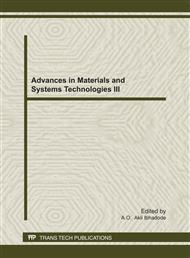p.739
p.745
p.753
p.779
p.795
p.801
p.807
p.815
p.827
Geophysical Survey as a Surface Tool in Groundwater Exploration in Delta North District, Nigeria
Abstract:
Geophysical survey based on electrical resistivity method employing the techniques of vertical electrical sounding (VES) was carried out in order to investigate Groundwater existence in Delta North District, of Nigeria. This research work became necessary in order to solve the problem of acute water shortage in the area by way of prospecting or searching for additional aquifers which would subsidize the existing one, domestically, industrially and agriculturally. Ten (10) vertical electrical sounding (VES) (uniformly distributed) tests were conducted in the area and its environs using “Schlumberger” electrode array. The VES were carried out with half current electrode spacing with the spread Im-928m at six (06) points per decade. The results of the interpretation identified wet sand/clean sand as perched aquifer which can deliver ground water to the bore-hole at perceptible rates between depths of 85m to 145m below sea level. The resistivity of the aquifer detected varied from 95.0 ohm-m to 110,000 ohm-m while the thickness ranged from 30.0m to 105.0m.
Info:
Periodical:
Pages:
795-800
Citation:
Online since:
October 2011
Authors:
Price:
Сopyright:
© 2012 Trans Tech Publications Ltd. All Rights Reserved
Share:
Citation:


